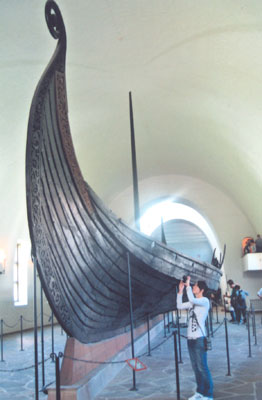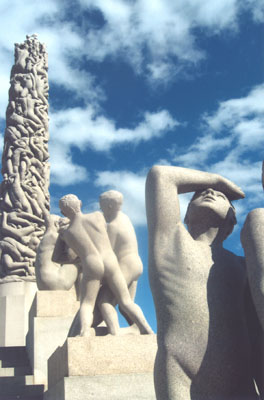A trio of Norwegian Viking ships
This item appears on page 60 of the December 2010 issue.
by Julie Skurdenis
Three of the most remarkable ships from the Viking Age rest together in an Oslo museum. Although discovered and excavated separately between 1867 and 1904, the three ships share much in common. All date from the ninth century AD. All were found on the Oslofjord, south of Olso. All once actually sailed Norway’s coastal waters or the open sea. And, finally, all were used later on as “coffins” for burial of presumably important Viking-era individuals.
Each of the three ships — the Oseberg, Gokstad and Tune — was hermetically sealed and, thus, preserved by the blue clay, stones and turf which covered them. Mounds were then built over the ship burials.
The Viking era spanned the years AD 750 to 1066, approximately. The era’s most prominent and fearsome symbol was the Viking longship, which sailed European and north Atlantic waters on voyages of marauding, trading or settling. The three ships found along the Oslofjord are similar, smaller versions of these longships.
The Oseberg
Upon entering the Viking Ship Museum, the first vessel the visitor sees is the Oseberg, an open boat built of oak, with a prow that sweeps majestically up into an intricately carved serpent’s head and a stern ending in a serpent’s tail. The Oseberg is 71 feet long and 17 feet at its broadest and was made to be rowed by 30 men. Fifteen pairs of oars were found with the ship.
Buried in the ship, within a wooden chamber erected on its stern, was a woman, about 50 years old at the time of her death, together with her young female servant, who most probably was sacrificed.
With them were oxen, dogs, horses and a goodly supply of household goods to make the deceased’s afterlife comfortable. Although her jewelry had been plundered long ago, kitchen utensils, looms, clothes, quilts, blankets and tapestries remained, giving us an excellent idea of what an upper-class, ninth-century Viking lady considered the necessaries of life.
Larger treasures, including three elaborately carved sleighs and a cart, are exhibited in a separate section at the back of the museum.
It is speculated that the Oseberg may have been the grave of Queen Åsa, the grandmother of Harald Hårfager, who is credited with consolidating much of Norway in the ninth and 10th centuries.
The Gokstad
The Gokstad, too, is an open oak boat although, at 77 feet long and 17½ feet at its widest, slightly larger than the Oseberg. It was rowed by 32 men. Unlike the Oseberg, the Gokstad is not decorated; nonetheless, it is a thing of timeless beauty in its simplicity.
Inside the wooden burial chamber erected on board lay a man about 60 years old dressed in fine apparel. He too did not go alone into the afterlife. With him were horses, dogs and a peacock, the latter an unusual creature to take into the afterlife but one indicative of his status.
The Gokstad’s warrior’s weapons had been plundered, like the Oseberg’s lady’s jewels, but decorated harness mountings had apparently been deemed worthless and left behind.
The Tune
The smallest of the three ships is the Tune, which is 65 feet long and 14 feet wide. It is exhibited in the same condition in which it was found in the ground. The wooden burial chamber displayed alongside the Tune is from the Gokstad.
A visit to the Historical Museum at Frederiks Gate 2 is recommended in combination with the Viking Ship Museum for its displays of Viking-era artifacts plus its charming “stuffed doll” displays illustrating facets of everyday Viking life.
Other “must sees”
The Viking Ship Museum would be on the top of my list if I could visit only one place in Oslo, but close behind would be Vigeland Sculpture Park, with the many life-size sculptures of Gustav Vigeland (1869-1943); the medieval Akershus Castle, within whose crypts lie several Norwegian kings; the shops and cafés of the semicircular Basarhallene, behind Oslo Cathedral; the National Gallery; a stroll along Karl Johans Gate from the Royal Palace to the main train station; a boat trip on the Oslofjord; an evening stroll and dinner in one of the restaurants on the Aker Brygge next to the harbor, and the new Oslo Opera House, where visitors can, unusually, walk uphill on the building itself to its roof.
If you go…
The Viking Ship Museum is located on the Bygdøy Peninsula and can be reached by ferry, leaving from in front of the Oslo City Hall (a 15-minute trip), or by bus No. 30 from central Oslo (20 minutes). Museum hours are 9 to 6 from May to September and 11 to 4 October to April. Admission is 50 kroner, about $8.
My husband and I stayed at the Thon Panorama Hotel, within walking distance of most of the things we wanted to see and do in central Oslo. It is very up to date and comfortable and serves an extensive breakfast buffet that is included in the room rate. We paid $254 per night, but there are frequent special offers. The Thon Panorama is one of 21 Thon hotels in Oslo and its immediate vicinity.
We flew SAS (www.flysas.com), our airline of choice to Scandinavia and the Baltics. I fly them so often, I practically have my name engraved on one of the seats.
An excellent website to check for information on Norway is www.visitnorway.com/us.


